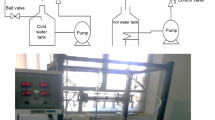Abstract
There is a growing demand for the removal of thermal energy from industrial applications. This paper investigates the heat transfer enhancement potential of microporous channels and nanofluid concentrations. The varying parameters of the experimental and numerical study are heat flux, permeability, and nanofluid concentration. The porosity that is used in the channels is 10 and 20 PPI. For the experimental and numerical studies, two concentrations are considered: 0.6% alumina (Al2O3) and distilled water. The study focuses on one flow rate, which is 6.309 × 10−5 m3 s−1. There are two different test blocks used: two and three microporous channels. The analysis of the average Nusselt number is considered, which determines the case that results in the optimal removal of thermal energy. The maximum average Nusselt number that is found is 135.5; the results are obtained from the three-channel test block with nanofluid with 0.6% alumina and 20 PPI inserts. It was found that the pressure drop can be considered negligible. A negligible pressure drop means that operating costs are minimal. Another observation is that the temperature distribution has optimal results when nanofluid with 0.6% alumina is used. Finally, the experimental and numerical studies are in good agreement with an average relative error of 3.3%, which is determined by analyzing the temperature distribution.









Similar content being viewed by others
References
Bayomy AM, Saghir MZ. Heat transfer characteristics of aluminum metal foam subjected to a pulsating/steady water flow: experimental and numerical approach. Int J Heat Mass Transf. 2016;97:318–36.
Bayomy AM, Saghir MZ, Yousefi T. Electronic cooling using water flow in aluminum metal foam heat sink: experimental and numerical approach. Int J Therm Sci. 2016;109:182–200.
Bayomy AM, Saghir MZ. Experimental study of using γ-Al2O3–water nanofluid flow through aluminum foam heat sink: comparison with numerical approach. Int J Heat Mass Transf. 2017;107:187–203.
Pourfarzad E, Ghadiri K, Behrangzade A, Ashjaee M. Experimental investigation of heat transfer and pressure drop of alumina–water nano-fluid in a porous miniature heat sink. Exp Heat Transf. 2018;31(6):495–512.
Tiwari AK, Ghosh P, Sarkar J. Performance comparison of the plate heat exchanger using different nanofluids. Exp Therm Fluid Sci. 2013;49:141–51.
Tiwari AK, Ghosh P, Sarkar J, Dahiya H, Parekh J. Numerical investigation of heat transfer and fluid flow in plate heat exchanger using nanofluids. Int J Therm Sci. 2014;85:93–103.
Tiwari AK, Ghosh P, Sarkar J. Particle concentration levels of various nanofluids in plate heat exchanger for best performance. Int J Heat Mass Transf. 2015;89:1110–8.
Nazari S, Toghraie D. Numerical simulation of heat transfer and fluid flow of water–CuO nanofluid in a sinusoidal channel with a porous medium. Phys E. 2017;87:134–40.
Toghraie D, Mahmoudi M, Akbari OA, Pourfattah F, Heydari M. The effect of using water/CuO nanofluid and L-shaped porous ribs on the performance evaluation criterion of microchannels. J Therm Anal Calorim. 2018;135:145–59.
Marzban A, Sheikhzadeh G, Toghraie D. Laminar flow and heat transfer of water/NDG nanofluid on tube banks with rhombic cross section with different longitudinal arrangements. J Therm Anal Calorim. 2019;138:1–11.
Ho CJ, Liu WK, Chang YS, Lin CC. Natural convection heat transfer of alumina-water nanofluid in vertical square enclosures: an experimental study. Int J Therm Sci. 2010;49:1345–53.
Ho CJ, Wei LC, Li ZW. An experimental investigation of forced convective cooling performance of a microchannel heat sink with Al2O3/water nanofluid. Appl Therm Eng. 2010;30:96–103.
Ho CJ, Chen WC. An experimental study on thermal performance of Al2O3/water nanofluid in a minichannel heat sink. Appl Therm Eng. 2013;50:516–22.
Bayomy AM. Electronic cooling using ERG aluminum foam subjected to steady/pulsating water and γ-Al2O3-water nanofluid flow: experimental and numerical approach, Ph.D. dissertation, MIE, RU, Toronto, ON, 2016
Buy Al2O3-monodisperse spherical nanoparticles in Aqueous media | Al2O3-monodisperse spherical nanoparticles in Aqueous media Online: MKNano.com, Mknano.com. [Online]. https://www.mknano.com/Nanoparticles/Single-Element-Oxides/Aluminum-Oxide-Nanopowder/Al2O3-monodisperse-spherical-nanoparticles-in-Aqueous-media. (2019). Accessed 10 Jun 2019.
Battleson, B.: Duocel® Aluminum Foam, ERG Aerospace. [Online]. http://ergaerospace.com/materials/duocel-aluminum-foam/ (2019). Accessed 10 Jun 2019.
COMSOL Multiphysics® Modeling Software, Comsol.com. [Online]. https://www.comsol.com/ (2019). Accessed 10 Jun 2019.
Acknowledgements
The authors would like to acknowledge the support they received from the National Science and Engineering Research Council of Canada and Ryerson University, which made this research possible.
Author information
Authors and Affiliations
Corresponding author
Additional information
Publisher's Note
Springer Nature remains neutral with regard to jurisdictional claims in published maps and institutional affiliations.
Rights and permissions
About this article
Cite this article
Delisle, C.S., Welsford, C.A. & Saghir, M.Z. Forced convection study with microporous channels and nanofluid: experimental and numerical. J Therm Anal Calorim 140, 1205–1214 (2020). https://doi.org/10.1007/s10973-019-09175-8
Received:
Accepted:
Published:
Issue Date:
DOI: https://doi.org/10.1007/s10973-019-09175-8




